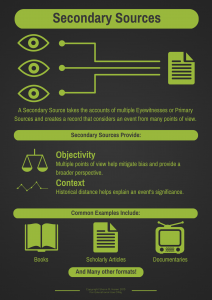3 Secondary research
Learning objectives
By the end of this chapter, students must be able to:
- Explain the concept of secondary research
- Highlight the key benefits and limitations of secondary research
- Evaluate different sources of secondary data
What is secondary research?
In situations where the researcher has not been involved in the data-gathering process (primary research), one may have to rely on existing information and data to arrive at specific research conclusions or outcomes. Secondary research, also known as desk research, is a research method that involves the use of information previously collected for another research purpose.
In this chapter, we are going to explain what secondary research is, how it works, and share some examples of it in practice.
Sources of secondary data
The two main sources of secondary data are:
- Internal sources
- External sources
Internal sources of secondary data exist within the organisation. There could be reports, previous research findings, or old documents which may still be used to understand a particular phenomenon. This information may only be available to the organisation’s members and could be a valuable asset.
External sources of secondary data lie outside the organisation and refer to information held at the public library, government departments, council offices, various associations as well as in newspapers or journal articles.
Benefits of using secondary data
It is only logical for researchers to look for secondary information thoroughly before investing their time and resources in collecting primary data. In academic research, scholars are not permitted to move to the next stage till they demonstrate they have undertaken a review of all previous studies. Suppose a researcher would like to examine the characteristics of a migrant population in the Western Sydney region. The following pieces of information are already available in various reports generated from the Australian Bureau of Statistics’ census data:
- Birthplace of residents
- Language spoken at home by residents
- Family size
- Income levels
- Level of education
By accessing such readily available secondary data, the researcher is able to save time, money, and effort. When the data comes from a reputable source, it further adds to the researchers’ credibility of identifying a trustworthy source of information.
Evaluation of secondary data
Assessing secondary data is important. It may not always be available free of cost. The following factors must be considered as these relate to the reliability and validity of research results, such as whether[1]:
- the source is trusted
- the sample characteristics, time of collection, and response rate (if relevant) of the data are appropriate
- the methods of data collection are appropriate and acceptable in your discipline
- the data were collected in a consistent way
- any data coding or modification is appropriate and sufficient
- the documentation of the original study in which the data were collected is detailed enough for you to assess its quality
- there is enough information in the metadata or data to properly cite the original source.
In addition to the above-mentioned points, some practical issues which need to be evaluated include the cost of accessing and the time frame involved in getting access to the data is relevant.
| Primary Research | Secondary Research |
| First-hand research to collect data. May require a lot of time | The research collects existing, published data. Requires less time |
| Creates raw data that the researcher owns | The researcher has no control over data method or ownership |
| Relevant to the goals of the research | May not be relevant to the goals of the research |
| The researcher conducts research. May be subject to researcher bias | The researcher only uses findings of the research |
| Can be expensive to carry out | More affordable due to access to free data (sometimes!) |
Table 2: Differences between Primary and Secondary Research
Media Attributions
- Marketing textbook image © Sally Tsoutsas - WSU photographer is licensed under a CC BY-NC-ND (Attribution NonCommercial NoDerivatives) license
- Secondary sources infographic © Shonn M. Haren is licensed under a CC BY (Attribution) license
- Griffith University, Research data: get started, 2022. ↵
- Qualtrics XM, Secondary research: definition, methods and examples, 2022. ↵



